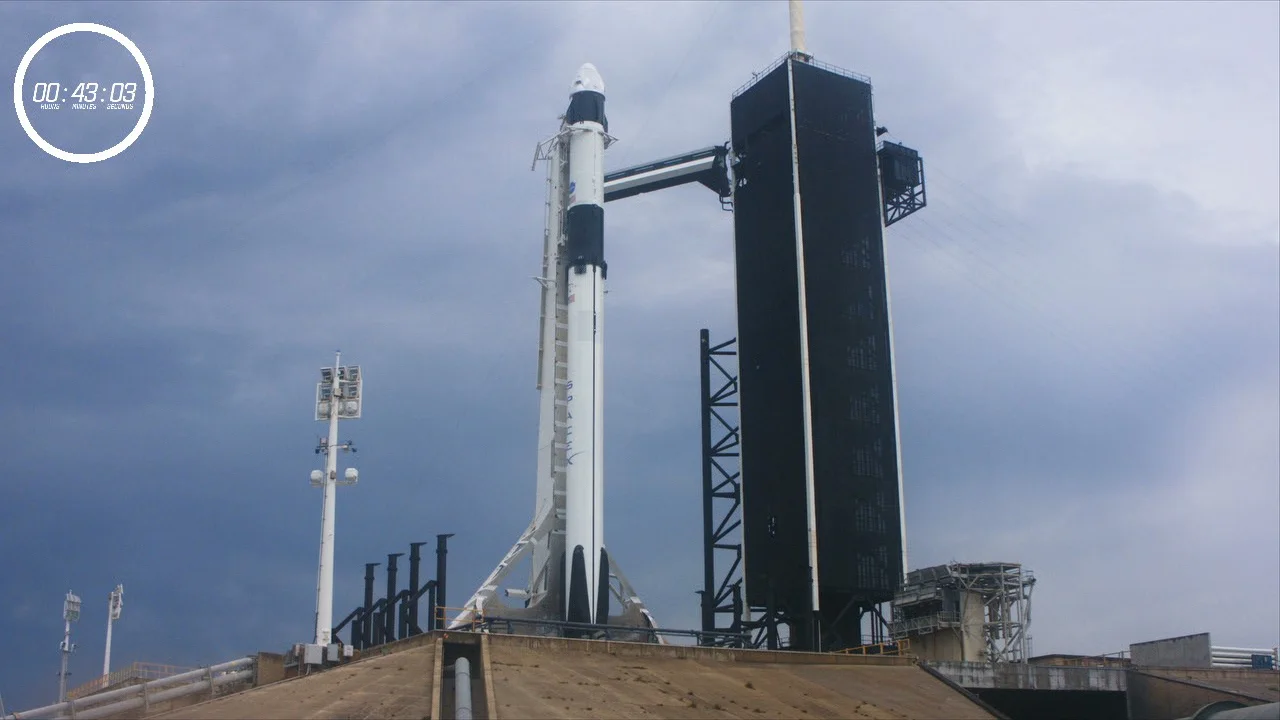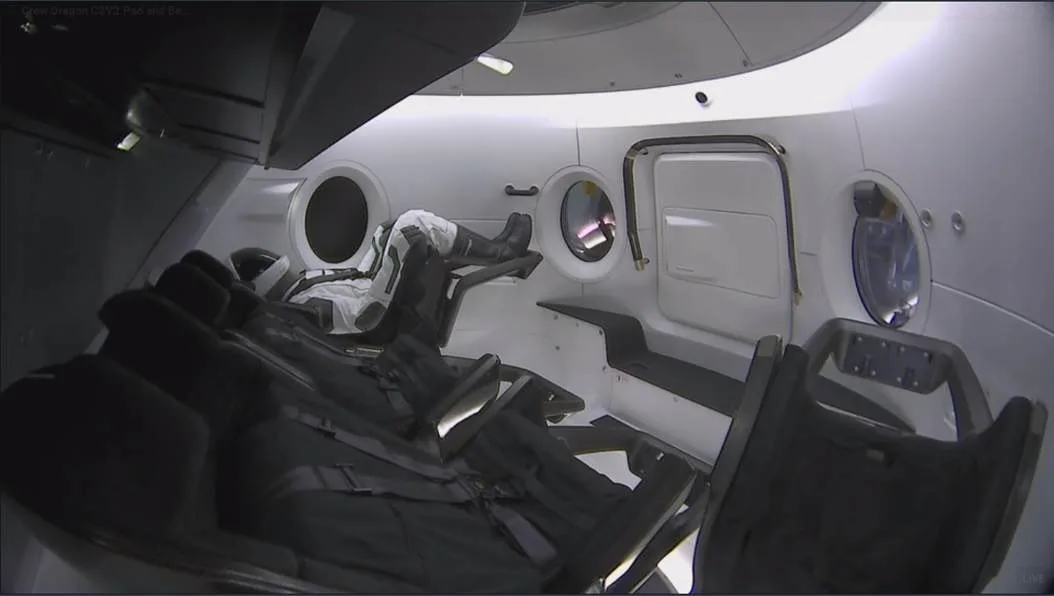
SpaceX's first crewed flight delayed by stormy Florida weather
Rocket, spacecraft and astronauts were all ready, but the weather did not cooperate
NASA and SpaceX are still counting on making history this week. Yet, thanks to stormy weather over Kennedy Space Center, the Demo-2 crewed launch to the International Space Station has been delayed until at least Saturday.
SpaceX's Crew Dragon spacecraft was set to launch into orbit today, atop a Falcon 9 booster rocket from Kennedy Space Center's historic Launch Complex 39A. As forecasters tracked weather conditions around the launch site, however, it became clear that safety concerns would cause them to scrub the launch for today. At just 17 minutes to lift-off, controllers made the final call to stand down.
The next launch window for Demo-2 is scheduled for Saturday, May 30, at 3:22 p.m. EDT.
Watch Below: Radar tracks unsettled weather across NASA, SpaceX launch site
WEATHER OR NOT
The updated weather forecast from the U.S. Air Force's 45th Weather Squadron on Wednesday morning gave only a 50 per cent chance of favourable conditions for the Demo-2 launch. The presence of Tropical Depression Bertha, to the northeast, may have contributed to poor weather conditions.
The primary weather concerns in the forecast were the potential for cumulus or cumulonimbus (anvil) clouds, and the possibility of flying through precipitation.
Cumulus or cumulonimbus clouds near the launch site would indicate the presence of turbulence and possibly strong upper-level wind shear. These conditions could disrupt the rocket's flight path, overtax its structural integrity or force it to consume too much fuel. Flying through precipitation raises the risk of the rocket gathering electric charge during flight, and being struck by lightning, which would be disastrous.
In the end, Demo-2 was scrubbed because the 45th Weather Squadron forecast team was concerned the electric field levels in the atmosphere were not dissipating fast enough.
Due to ice crystals and snow pellets bumping together on the updrafts and downdrafts, storms produce large regions of electric charge at the top, middle and bottom of the cloud, which generates strong electric fields. This is how lightning is produced during thunderstorms, and a rocket launching in such an environment would act as a lightning rod, potentially resulting in disaster for the mission and crew.
Read: Lightning strikes almost doomed the 1969 Apollo 12 Moon mission
Also of concern were the weather and water conditions down-range of the launch site. Should something go wrong, Crew Dragon would intentionally eject from the Falcon 9 rocket and splashdown in the Atlantic Ocean. Conditions along the flight path, therefore, need to be safe enough for the capsule to splashdown, and for the rescue teams to retrieve the astronauts.

At 12:25 p.m. EDT, May 27, 2020, SpaceX's crewed Demo-2 launch stands ready for lift-off, with significant cloud visible near Launch Complex 39A. Credit: NASA TV
Whether a mission launches on time sometimes comes down to the at-the-moment weather conditions. Even if stormy weather is crossing the launch site before lift-off, they could catch a break in the active weather, or they could get unlucky and the weather is still too sketchy to risk it.
As of May 28, the weather forecast is currently giving a 60 per cent chance of favourable launch conditions for both the Saturday, May 30 and Sunday, May 31 launch windows. The 45th Weather Squadron will update this daily.
HISTORY IN THE MAKING
This Demo-2 mission will be history-making in two ways. First, this will be the first-ever commercial launch to carry astronauts to the International Space Station. Second, it will be the first crewed launch from American soil since the Space Shuttle program ended nearly a decade ago.
"We are so proud and happy for Doug and Bob," astronaut Nicole Mann, who is slated to fly on a future commercial launch on Boeing's Starliner spacecraft, said in a NASA statement. "It feels kind of like one of your close family members having a great lifetime achievement — and really, that's what it is."
The instantaneous launch window for this important mission was scheduled to reach 'T-minus zero' at 4:33 p.m. EDT on Wednesday, May 27, 2020. NASA TV began their livestream of the launch at 12:15 p.m. EDT. Watch below for full coverage of the scrubbed launch.
If all went as planned, the Falcon 9 booster would have completed the journey to orbit, carrying Behnken and Hurley on board the Crew Dragon in just under 9 minutes. They would then be on-route for a rendezvous with the International Space Station at 11:39 a.m. EDT on Thursday, May 28.
By the time the pair of astronauts got to experience the weightlessness of being in orbit, the 1st stage of the Falcon 9 rocket would already be moments away from setting down on the droneship "Of Course I Still Love You" out on the Atlantic Ocean.

SpaceX's flight profile for the Demo-2 mission. The Crew Dragon is expected to reach orbit in just 8 minutes and 47 seconds after lift-off, while the Falcon 8 1st stage is scheduled to touch down at 9 minutes, 22 seconds after launch. Credit: NASA TV
A mission's 'launch window' is the time set by ground controllers where a rocket can lift off and be in the best position to deploy a satellite properly, or for a spacecraft to rendezvous with the International Space Station. Once a launch window opens, often, there is a certain amount of time where a rocket can delay and still accomplish its mission. Other missions, such as Demo-2, have an 'instantaneous launch window'. This means that the rocket must lift off at the exact moment the timer reaches T-zero. Otherwise, the launch must be aborted for that day and delayed until the next launch window opens.
If Demo-2 cannot lift off on Saturday at 3:22 p.m. EDT, NASA and SpaceX have set an alternative launch window for 3 p.m. EDT on Sunday, May 31.

SpaceX Demo-1 performed flawlessly on launch and arrival to the International Space Station back on March 2, 2019. Credit: NASA TV
NEXT-GEN SPACEFLIGHT
Past spacecraft that have carried astronauts into orbit were marvels of technology. SpaceX's Crew Dragon, on the other hand, looks to be something straight out of science fiction that has been made real.

NASA astronauts Doug Hurley (foreground) and Bob Behnken sit in the Crew Dragon capsule, which is equipped with touch-screen controls. Credit: NASA
Although the two astronauts appear cramped in the above photograph, the Crew Dragon is surprisingly roomy when compared to older spacecraft. Even the current Soyuz capsules are very crowded, with little room for the astronauts and cosmonauts to move around during a launch.

SpaceX's "anthropomorphic test device" or ATD, named "Ripley", made the trip to the ISS during the uncrewed Demo-1 mission. It was certainly not crowded on this flight. Credit: NASA TV
According to NASA: "As the final flight test for SpaceX, this mission will validate the company's crew transportation system, including the launch pad, rocket, spacecraft, and operational capabilities. This also will be the first time NASA astronauts will test the spacecraft systems in orbit."
Sources: NASA | SpaceX | 45th Weather Squadron










